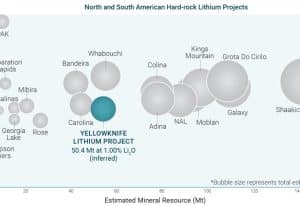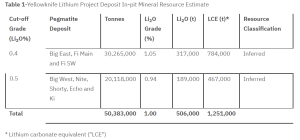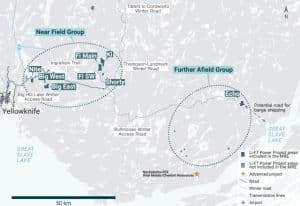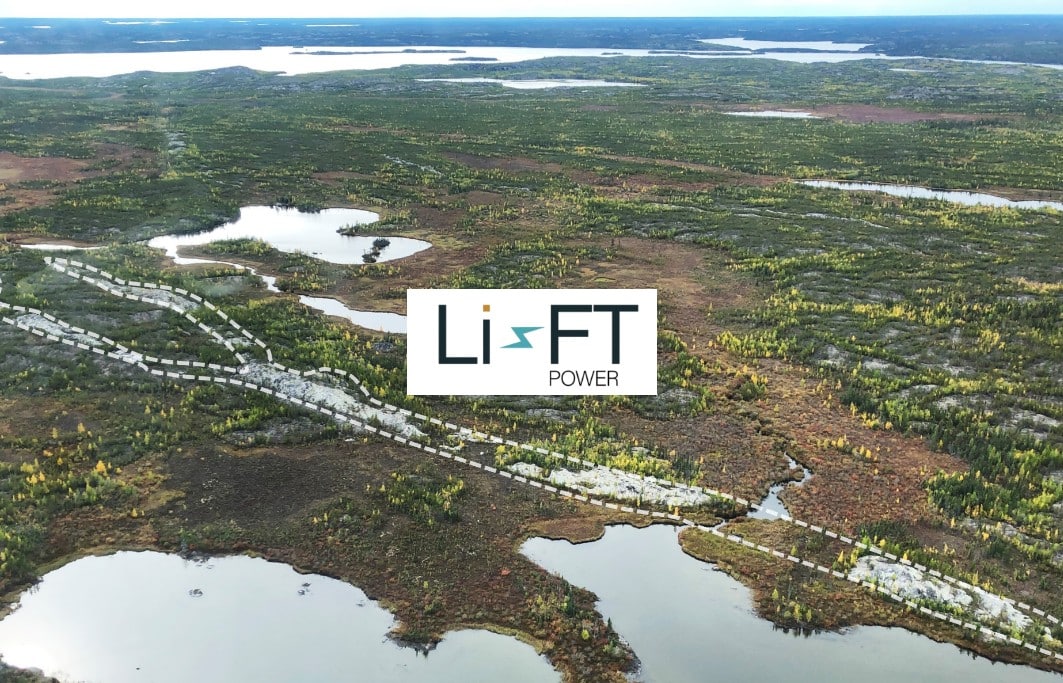Disseminated on behalf of Li-FT Power Ltd.
Li-FT Power Ltd. (TSXV: LIFT) has announced its first-ever National Instrument 43-101 (NI 43-101) compliant mineral resource estimate (MRE) for the Yellowknife Lithium Project (YLP), located in the Northwest Territories, Canada. This maiden estimate is a major milestone for the company and marks a significant step forward in the project’s development.
The resource estimate positions the Yellowknife Lithium Project as a globally important spodumene resource, making it one of the top 10 largest spodumene projects in the Americas.

A Lithium Giant Emerges: Key Highlights of the Maiden MRE
The Yellowknife Lithium Project’s initial MRE reveals a total of 50.4 million tonnes grading 1.00% lithium oxide (Li₂O). That is equal to around 506,000 tonnes of Li₂O or 1.25 million tonnes of lithium carbonate equivalent (LCE). This significant volume of lithium-rich spodumene places the Yellowknife Project among the largest hard-rock lithium deposits in Canada, currently ranked as the 3rd-largest hard-rock maiden resource in the country.

The estimate includes 8 of the 13 spodumene-bearing pegmatite dykes located on the property. However, the majority of these deposits remain open at depth, with 6 of the 8 dykes in the estimate showing unconstrained mineralization. This opens the door for substantial resource expansion through future drill programs.

In addition, 5 undrilled spodumene dykes on the property are not yet included in the MRE, presenting further upside potential for growth as exploration continues.
The maiden resource estimate is based on data gathered from 49,548 meters of diamond drilling, completed across 286 holes between June 2023 and April 2024. While the estimate represents a substantial resource, it is only the beginning, with Li-FT aiming to build on these early findings as additional exploration and drilling are conducted over the coming years.

Strategic Positioning and Infrastructure Benefits
One of the Yellowknife Lithium Project’s significant advantages is its excellent access to infrastructure. The Ingraham Trail, a government-maintained paved highway, runs through part of the project’s mineral resource area, providing convenient transportation links.

Moreover, the project is close to rail facilities at Hay River, which is connected to major ports in Prince Rupert and Vancouver. This logistical infrastructure is critical for future shipping, especially to key markets in Asia, where lithium demand continues to grow as the global transition to electric vehicles accelerates.
The project is also close to existing powerlines near Yellowknife, which will help reduce development and operational costs. This infrastructure positioning enhances the project’s economic viability and makes it well-suited for future large-scale mining and processing operations.
Metallurgical Testing and Processing Potential
The metallurgical work conducted to date confirms the suitability of the Yellowknife Lithium Project’s spodumene-bearing pegmatites for dense medium separation (DMS) processing. DMS is a cost-effective method for separating lithium from spodumene, and initial testing has shown that this technique can be applied successfully to the YLP deposits.
X-ray diffraction analysis and pilot-scale testing completed as part of the Yellowknife Lithium Project’s metallurgical program have confirmed the presence of simple lithium mineralogy in the pegmatites. The confirmation that low-cost DMS processing is suitable for the spodumene dykes included in the maiden resource estimate adds further confidence in the project’s potential to be a low-cost lithium producer.
Yellowknife’s Road to Lithium Dominance
With the maiden resource estimate now in place, Li-FT Power is moving forward with plans to conduct a Preliminary Economic Assessment (PEA) for the Yellowknife Lithium Project. The PEA will evaluate the project’s economic feasibility, including factors such as capital and operating costs, potential production rates, and overall project profitability.
Li-FT expects to complete the PEA in the second quarter of 2025, marking another critical step toward bringing the lithium project into production. The company’s management views this initial resource estimate as a foundation for growth. CEO Francis MacDonald expressed optimism about the project’s future, saying that:
“The announcement of Li-FT’s first NI 43-101 mineral resource estimate for the Yellowknife Lithium Project marks a significant milestone for both the company and the Northwest Territories.”
What Lies Ahead For Lithium
The opportunities presented by the Yellowknife Lithium Project are immense. As the world shifts towards electrification and renewable energy, lithium demand is expected to soar, driven by the growth of electric vehicles (EVs) and energy storage systems. Projects like Yellowknife, with its large, high-grade lithium resources, will play a crucial role in meeting this demand, stabilizing lithium prices and supporting the global transition to cleaner energy.
The Northwest Territories, with its rich mineral endowment and supportive mining infrastructure, is well-positioned to become a key player in the global lithium supply chain. The Yellowknife Lithium Project has the potential to be a cornerstone asset in the region’s mining future.
With 50.4 million tonnes of inferred resources and substantial room for expansion, the project could become a key contributor to North America’s lithium supply. As Li-FT Power advances and continues exploration, this development represents a major opportunity in the rapidly growing lithium market.
Disclosure: Owners, members, directors, and employees of carboncredits.com have/may have stock or option positions in any of the companies mentioned: LIFT.
Carboncredits.com receives compensation for this publication and has a business relationship with any company whose stock(s) is/are mentioned in this article.
Additional disclosure: This communication serves the sole purpose of adding value to the research process and is for information only. Please do your own due diligence. Every investment in securities mentioned in publications of carboncredits.com involves risks that could lead to a total loss of the invested capital.


